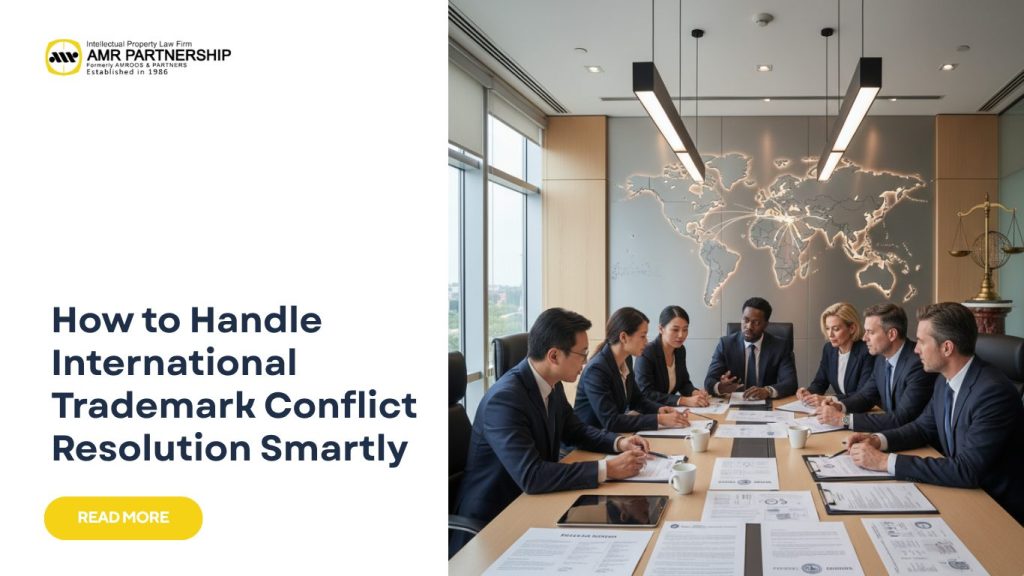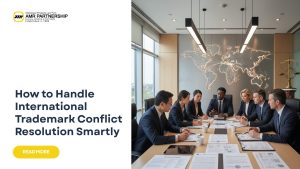
In today’s fast-moving global market, your brand doesn’t just live in one place — it lives online, in stores, and across borders. And with that comes one of the biggest legal challenges businesses face in 2025 which is international trademark conflict resolution. Whether you’re part of the design industry, creative sector, or tech space, understanding how to protect your intellectual property (IP) across multiple jurisdictions is crucial.
When your trademark travels globally, it may encounter unexpected issues — someone else using your name in another country, a similar logo popping up on e-commerce platforms, or disputes over brand ownership in joint ventures. That’s why many companies turn to experienced IP professionals from AMR.CO.ID to manage these conflicts efficiently, helping you avoid long, expensive legal battles.
READ MORE: How to Trademark Registration in Indonesia: A Simple Guide for You
Why Trademark Conflicts Are Getting Trickier Than Ever
Trademark disputes are no longer confined to traditional products. They now extend to NFTs, AI-generated content, and even metaverse identities. With brands entering new digital frontiers, international trademark conflict resolution becomes a vital business strategy, not just a legal requirement.
Recent cases have highlighted how complex this can get:
- Dewberry v. Dewberry Group (2025) clarified how corporate entities must be clearly linked in lawsuits to claim profits. Many companies miss this step and lose valuable time in litigation.
- Yuga Labs v. Ryder Ripps (2025) raised questions about creative freedom vs. trademark infringement — especially in the digital art and NFT world.
- Reed v. Marshall (2025) showed how unclear ownership in partnerships can lead to costly disputes.
These examples reflect a broader truth — global markets blur boundaries. Your design, product, or content can appear anywhere online, and so can your competitors. Without proactive IP protection, your brand could be vulnerable long before you even notice it.
The Real Reason Why International Trademark Disputes Happen
Most cross-border conflicts begin innocently. A local company expands abroad, unaware that its brand name already exists in another country. Or, a business partner registers a mark under their own name during collaboration. The digital era adds even more layers — from domain name squatting to similar trademarks appearing in the metaverse.
Here’s what typically triggers global disputes:
- Two companies unintentionally using similar marks after international expansion.
- Trademark registered first by another entity in a foreign market.
- Misunderstanding over ownership in joint ventures.
- NFTs or AI-created designs copying brand elements.
Each of these problems grows fast if not handled early. Once multiple jurisdictions are involved, legal complexity increases — and so does the cost. That’s why smart businesses integrate preventive steps early, ensuring they have global monitoring and registration strategies ready before scaling internationally.
What’s New in 2025, Global Lessons and Insights
The legal landscape is adapting fast to new technologies and global commerce. In 2025, we’ve seen key changes in how international conflicts are resolved:
- Broader Recognition of Digital Trademarks — Authorities now recognize that virtual goods and digital identities can be trademarked, protecting brands in the metaverse and beyond.
- Stronger Emphasis on Mediation — Many cases are resolved via the World Intellectual Property Organization (WIPO) instead of courts, saving time and cost.
- Increased Cooperation Between Countries — IP offices across ASEAN, EU, and the US are collaborating to make cross-border dispute resolution smoother.
These updates show one thing clearly — international protection isn’t optional anymore. Whether you’re in fashion, design, or tech, it’s essential to manage trademarks globally.
READ MORE: How Trademark Licensing Works Lessons from Taylor Swift’s IP Strategy
How International Trademark Conflict Resolution Works in Practice
When a dispute arises, it’s not always about heading straight to court. There are strategic stages companies can take:
1. Negotiation and Settlement
Many conflicts can be resolved through direct talks — adjusting branding, defining markets, or licensing agreements. This saves resources and preserves business relationships.
2. Arbitration and Mediation
Organizations like WIPO offer arbitration for faster, confidential settlements. It’s especially useful when disputes involve multiple countries, as it avoids navigating numerous national courts.
3. Court Litigation
If other methods fail, court action may be necessary. However, each jurisdiction follows its own rules. That’s why having experienced international legal counsel is key — someone who can coordinate across borders and represent your brand’s best interest.
For businesses expanding globally, these stages should be built into a wider IP strategy. You’re not just solving problems; you’re building brand resilience.
READ MORE: Lessons from Global Trademark Disputes and the Value of a Trademark Licensing Company in Indonesia
The Common Challenges Brands Face in Global IP Battles
Cross-border IP disputes come with their own unique hurdles, such as:
- Jurisdiction differences mean every country interprets intellectual property laws in its own way, making global protection more complicated
- Late registration can give others the chance to claim your mark before you do
- Online platforms often blur territorial boundaries, creating confusion about ownership across regions
- Cultural nuances can turn a name or logo that works well in one market into something completely different in another
Addressing these issues early can save you from serious financial and reputational damage. It’s always easier to prevent than to cure — global registration, trademark monitoring, and professional legal consultation are key.
READ MORE: How to Get Trademark License: Lessons from a Licensing Expert at a Federal Agency
How AMR Partnership Protects Your Brand Globally
Through years of experience handling international trademark conflict resolution, AMR offers full-spectrum IP protection and enforcement. Here’s why many global clients choose AMR:
- A global network built through collaboration with more than a thousand partner firms across over seventy countries
- Strategic solutions designed to support negotiation mediation and litigation effectively
- Strong regulatory expertise with deep knowledge of regional IP frameworks including ASEAN and WIPO systems
- Preventive protection through clear guidance on trademark ownership licensing and dispute prevention
AMR focuses not just on resolving disputes but ensuring they don’t happen again. From registration to enforcement, the firm ensures your creative and commercial assets stay protected — globally.
READ MORE: Understanding Trademark License Agreement Template: A Simple Guide for Business Owners
Moving Forward — Secure Your Brand Before Conflict Arises
As global trade, AI, and digital design evolve, brand identity becomes both more valuable and more vulnerable. Businesses that take early action — auditing trademarks, defining ownership, and filing internationally — stand stronger when conflicts appear.
If you want to avoid the heavy costs of legal battles, it’s time to act now. Consult IP professionals who specialize in global protection and cross-border dispute management. Pricing for tailored IP conflict handling services starts from a competitive range — details are available through private consultation.
Ready to protect your brand internationally? Connect with our IP team today via WhatsApp or follow us on Instagram for updates. Stay proactive, not reactive — your brand deserves to thrive globally, not just locally.
- Phone (Hunting): +62-21-29036668
- Fax: +62-21-29036672 to 75
- WhatsApp Customer Service: Click here to chat
- Instagram: @amrpartnership
- TikTok: @amr.partnership
- Facebook: Law Firm AMR Partnership
- Official Website: www.amr.co.id






